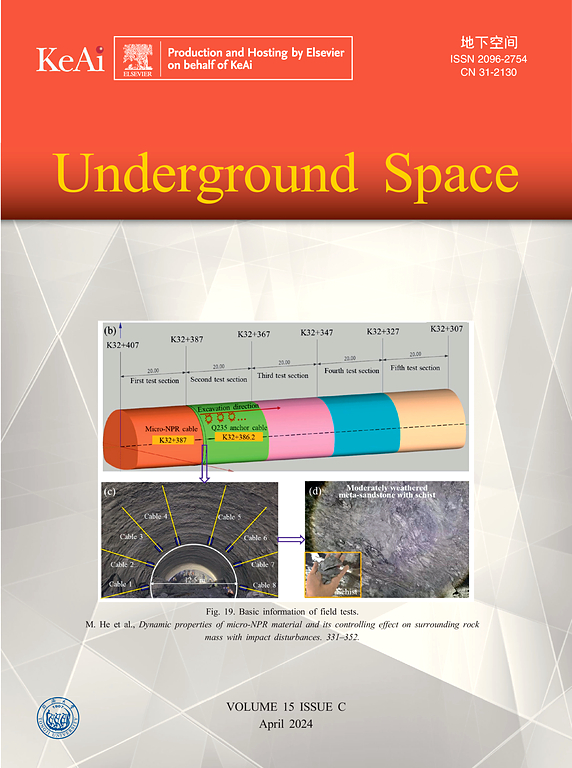不同岩石强度数据约束下六种完整岩石破坏准则三种统计方法的基准研究
IF 8.3
1区 工程技术
Q1 ENGINEERING, CIVIL
引用次数: 0
摘要
为了减少潜在强度异常值对参数估计的影响,提出了基于最小中位数平方和最小绝对偏差的统计方法来替代传统的最小二乘法。然而,很少有研究对这些不同统计方法的性能进行比较。本研究介绍了一种新的程序,用于评估六个选定岩石破坏标准的三种统计方法,受各种岩石强度数据集的约束。最佳拟合破坏准则的一致性和强度参数估计的鲁棒性是评价的主要标准。基于基准分析,得出以下结论。首先,最小二乘法和最小绝对偏差法在确定给定岩石强度数据集的最佳拟合破坏准则方面表现相当,而最小中位数二乘法则不然。其次,在使用复杂度较低的常规试验数据进行二维破坏准则强度参数估计时,建议采用最小绝对偏差法获得鲁棒参数估计。第三,随着常规试验数据复杂性的增加或使用真三轴试验数据估计三维破坏准则的强度参数时,通过分析预测误差来评估异常值倾向是必要的。如果预测误差的峰度小于3,则首选最小二乘法。否则,应采用最小绝对偏差法来减轻潜在强度异常值的影响。这一基准研究为未来不同统计方法在岩石力学中的应用提供了有价值的见解。本文章由计算机程序翻译,如有差异,请以英文原文为准。
Benchmark study of three statistical methods for six intact rock failure criteria constrained by different rock strength data
To reduce the impact of potential strength outliers on parameter estimation, statistical methods based on the least median square and least absolute deviation have been proposed as alternatives to the traditional least square method. However, little research has been conducted to compare the performance of these different statistical methods. This study introduces a novel procedure for evaluating the three statistical approaches across six selected rock failure criteria, constrained by various rock strength datasets. The consistency of the best-fitting failure criterion and the robustness of the strength parameter estimations serve as the primary benchmarks for evaluation. Based on the benchmark analysis, the following conclusions are drawn. First, both the least square and least absolute deviation methods perform equivalently in identifying the best-fitting failure criterion for a given rock strength dataset, whereas the least median square method does not. Second, when estimating the strength parameters in a two-dimensional failure criterion with the conventional test data of low complexity, the least absolute deviation method is recommended for obtaining robust parameter estimations. Third, as the complexity of conventional test data increases or when true triaxial test data are used to estimate strength parameters for a three-dimensional failure criterion, it is essential to evaluate the outlier-proneness by analyzing the prediction error. If the kurtosis of the prediction error is less than 3, the least square method is preferred. Otherwise, the least absolute deviation method should be used to mitigate the influence of potential strength outliers. This benchmark study offers valuable insights for the future application of different statistical methods in rock mechanics.
求助全文
通过发布文献求助,成功后即可免费获取论文全文。
去求助
来源期刊

Underground Space
ENGINEERING, CIVIL-
CiteScore
10.20
自引率
14.10%
发文量
71
审稿时长
63 days
期刊介绍:
Underground Space is an open access international journal without article processing charges (APC) committed to serving as a scientific forum for researchers and practitioners in the field of underground engineering. The journal welcomes manuscripts that deal with original theories, methods, technologies, and important applications throughout the life-cycle of underground projects, including planning, design, operation and maintenance, disaster prevention, and demolition. The journal is particularly interested in manuscripts related to the latest development of smart underground engineering from the perspectives of resilience, resources saving, environmental friendliness, humanity, and artificial intelligence. The manuscripts are expected to have significant innovation and potential impact in the field of underground engineering, and should have clear association with or application in underground projects.
 求助内容:
求助内容: 应助结果提醒方式:
应助结果提醒方式:


